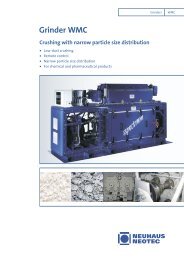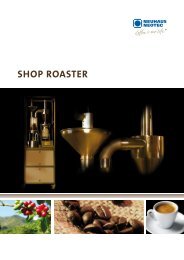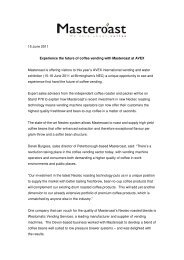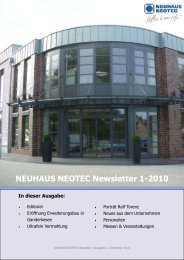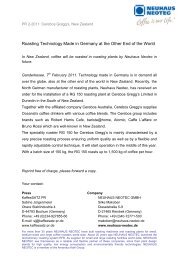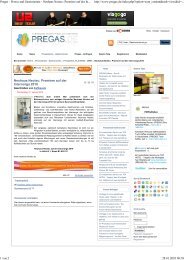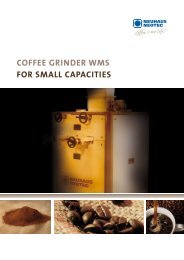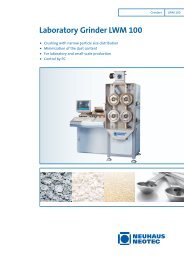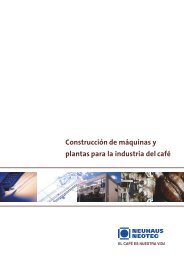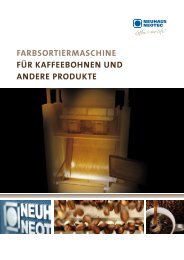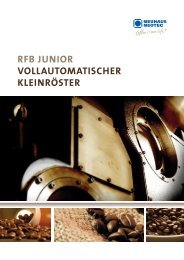a publication of the kahl group - Amandus Kahl GmbH & Co. KG
a publication of the kahl group - Amandus Kahl GmbH & Co. KG
a publication of the kahl group - Amandus Kahl GmbH & Co. KG
You also want an ePaper? Increase the reach of your titles
YUMPU automatically turns print PDFs into web optimized ePapers that Google loves.
A PUBLICATION OF THE KAHL GROUP
<strong>kahl</strong> <strong>group</strong><br />
PREFACE<br />
Dear Business Friend,<br />
We are pleased to inform you on current developments <strong>of</strong> our Group in this new journal.<br />
Also in this issue <strong>of</strong> our journal we give priority to innovations within our Group.<br />
To be able to implement <strong>the</strong> new developments we need you, dear business friend, and<br />
your readiness to tread new paths with <strong>the</strong> assistance <strong>of</strong> our employees. After all, <strong>the</strong><br />
success <strong>of</strong> your investment also matters to us. We are particularly proud <strong>of</strong> having won<br />
<strong>the</strong> Apprenticeship Award 2009 by <strong>the</strong> IHK (Chamber <strong>of</strong> Industry and <strong>Co</strong>mmerce) for our<br />
exemplary performance in in-company training. For one thing is certain: The qualification<br />
<strong>of</strong> our employees is a decisive factor for future success.<br />
Your<br />
Jan Behrmann & Joachim Behrmann<br />
02/03<br />
Photo: Hamburger Abendblatt Birgit Jaklitsch / Birgit Schcking.
THE KAHL GROUP
TABLE OF CONTENTS<br />
AmAnDuS KAHL<br />
06 »<strong>Kahl</strong> reinvents <strong>the</strong> wheel«<br />
08 Large-scale plants for wood pelleting –<br />
Plantation Energy Australia<br />
09 Residue-free recycling <strong>of</strong> waste tyres –<br />
From tyres to granulate<br />
10 Recycling <strong>of</strong> polyethylene terephthalate<br />
(abbreviation PET)<br />
11 Research & Development at <strong>Amandus</strong> <strong>Kahl</strong><br />
12 The sports activities <strong>of</strong> <strong>the</strong> <strong>Kahl</strong> Group<br />
14 Application <strong>the</strong> flat die pelleting press 14-175<br />
16 A complete feedmill with innovative<br />
technologies in Tatarstan<br />
18 <strong>Co</strong>ke dust pellets for steel smelting furnaces<br />
19 Success in <strong>the</strong> oil palm industry –<br />
<strong>Kahl</strong> has taken <strong>the</strong> first flat die pelleting press for<br />
pellets from empty fruit bunches into operation<br />
19 The Crown Expander –<br />
Pelleting without a pelleting press<br />
20 HoweE Eberswalde –<br />
The first pan grinder mill applied in practice<br />
SPECIAL<br />
nEuHAuS nEOTEC<br />
21 Finer than fine<br />
22 Energy saving due to preheating <strong>of</strong> c<strong>of</strong>fee beans<br />
23 new drum roaster CTR - 3000<br />
24 Particle technology<br />
25 GmP - Grinders<br />
25 Heinen Freezing<br />
25 Sunflower seeds perfectly roasted<br />
27 The perfect espresso<br />
28 Paulig<br />
29 Enlargement <strong>of</strong> Premises<br />
SCHuLE<br />
30 Oilseed processing plant<br />
for sunflower, soya and rape<br />
30 Start-up <strong>of</strong> a rice mill in Peru<br />
32 High nutritional value <strong>of</strong> durum wheat (bulgur)<br />
32 new ways <strong>of</strong> oats processing in Belarus<br />
33 Precision <strong>of</strong> separation at 1,000 tons<br />
per day in <strong>the</strong> oil industry<br />
33 Schule – Food Technology<br />
34 Bioethanol – Higher pr<strong>of</strong>it without shell<br />
34 nigeria – promotion and development<br />
<strong>of</strong> agricultural resources<br />
FROm OuR mAnuFACTuRInG DEPARTmEnT<br />
36 Expansion <strong>of</strong> die manufacturing building<br />
37 new bending machine for<br />
apparatus construction<br />
37 Award for exemplary vocational<br />
education and training<br />
04/05
amandus <strong>kahl</strong><br />
»KAHL REINVENTS THE WHEEL – THE PAN GRINDER MILL!«<br />
our competitors say that <strong>the</strong> energy consumption <strong>of</strong> our pel-<br />
leting presses is higher as cylindrical pan grinder rollers run<br />
on a circular path and <strong>the</strong> resulting shearing effect makes our<br />
machine an energy guzzler. For decades we have been proving<br />
every day that this is not true. partly, we have eliminated this ef-<br />
fect by using conical rollers, mainly in order to achieve a fur<strong>the</strong>r<br />
temperature reduction for example during hop pelleting.<br />
meanwhile we have acted on our competitors' suggestions and<br />
remembered what pan grinder rollers originally have been used<br />
for: for crushing various products, mainly grain. Even when driv-<br />
en by muscle power pan grinder rollers have been a well-proven<br />
technology for centuries. But joking aside – also in <strong>the</strong> recent<br />
past <strong>kahl</strong> pelleting presses have always had <strong>the</strong> edge on o<strong>the</strong>r<br />
processes when it comes to pelleting fibrous products such as<br />
straw, grass or dried beet pulp. Thanks to <strong>the</strong> much-maligned<br />
shearing effect, <strong>the</strong> machine can process also coarse particles<br />
without any problem. The fact that it is used for crushing waste<br />
tyres impressively proves <strong>the</strong> efficiency <strong>of</strong> <strong>the</strong> <strong>kahl</strong> pelleting<br />
press. nowadays, wood pelleting has gained worldwide acceptance.<br />
Wood pellets are trading goods and in <strong>the</strong>ir quality as a<br />
fuel <strong>the</strong>y definitely compete with oil and gas. as <strong>the</strong> demand for<br />
pellets increases, <strong>the</strong> demand for saw dust and wood shavings<br />
increases as well. as an alternative, wood chips can be processed<br />
which, however, have to be crushed in wet condition before drying.<br />
Traditional methods such as knife ring flakers or hammer<br />
mills can be used, yet <strong>the</strong>y have several disadvantages. In fast<br />
running mills <strong>the</strong>re is a tendency to product clogging if <strong>the</strong> input<br />
product is too wet. Wood chips may have a water content <strong>of</strong> up<br />
to 50 % and hammer mills have to be aspirated, <strong>the</strong> exhaust air<br />
being discharged through a filter.<br />
Fast running mills produce sound emissions which are far beyond<br />
<strong>the</strong> limit <strong>of</strong> 85 dba. knife ring flakers, well-proven machines<br />
in <strong>the</strong> chipboard industry, require regular maintenance<br />
at short intervals. The match-like structures <strong>of</strong> <strong>the</strong> product may<br />
cause problems in conveying elements and <strong>the</strong> downstream pelleting<br />
plant. Questions <strong>of</strong>ten generate ideas: What happens to<br />
wet wood chips in a <strong>kahl</strong> pelleting press? answer: due to <strong>the</strong><br />
high moisture content <strong>the</strong> pellets will disintegrate. so what? If<br />
<strong>the</strong> pellets disintegrate, this means that <strong>the</strong> particles are small<br />
enough to have fitted through <strong>the</strong> die holes before! Intriguing,<br />
isn't it? <strong>of</strong> course, it is not as easy as that. But this questionand-answer<br />
game led to first trials in <strong>the</strong> pilot plant and later in<br />
practice – successful tests which raised new questions:<br />
• Which throughput is reached at which moisture content?<br />
• Which influence do <strong>the</strong> input particle sizes G 30 or G 50 have?<br />
• Which are <strong>the</strong> optimum perforations <strong>of</strong> <strong>the</strong> die?<br />
• How can <strong>the</strong> output product be dried?<br />
• Can we even do without wet grinding?<br />
• What shall we call this new technology?<br />
• How will <strong>the</strong> markets react to this new technology?<br />
View into <strong>the</strong> pan grinder mill
This new idea aroused immense enthusiasm in our technical<br />
and sales departments so that numerous measurements were<br />
carried out in various fields <strong>of</strong> application and <strong>the</strong> majority <strong>of</strong><br />
all open questions could be answered rapidly. The markets' re-<br />
action to this new technology has been more than positive. A<br />
customer in Poland bought <strong>the</strong> first »pan grinder mill« before<br />
<strong>the</strong> machine had been <strong>of</strong>ficially released for sale. Today, this<br />
pan grinder mill type 37-850 processes 6 – 7 t/h <strong>of</strong> G30 wood<br />
chips. The crushed wood chips are dried to a residual mois-<br />
ture content <strong>of</strong> approx. 10 % in a drum drier and subsequently<br />
<strong>the</strong>y are directly pelleted. Thus, <strong>the</strong> answer to <strong>the</strong> question if<br />
dry grinding can be dispensed with is yes. Later, this was confirmed<br />
in our plant at HoWee at Eberswalde. Our live demonstrations<br />
<strong>of</strong> <strong>the</strong> pan grinder mill at trade fairs in Stuttgart and<br />
Hanover were a complete success and <strong>Kahl</strong> was awarded an<br />
innovation prize for <strong>the</strong> pan grinder mill in Stuttgart.<br />
Which advantages does <strong>the</strong> pan grinder mill have when used for<br />
crushing wood chips? The following arguments are convincing:<br />
• No aspiration is required.<br />
• The sound emissions are below 75 dbA<br />
• Drying <strong>of</strong> <strong>the</strong> defibered wood is more economic.<br />
• The fibres produced by <strong>the</strong> pan grinder mill<br />
ensure an improved pellet quality.<br />
• Dry grinding can be dispensed with if <strong>the</strong><br />
die perforation is 6 mm<br />
• High moisture contents do not cause problems but<br />
reduce <strong>the</strong> specific energy consumption<br />
06/07<br />
nothing now can stop a rapid market relaunch <strong>of</strong> <strong>the</strong> pan<br />
grinder mill. This »new« machine has been used successfully<br />
as a pelleting press all over <strong>the</strong> world and has been optimised<br />
throughout decades. The wide-ranging type series covers every<br />
capacity requirement. After a demonstration at a trade fair, a<br />
large German sawmill cancelled <strong>the</strong> hammer mill that had already<br />
been ordered and ordered a pan grinder mill for about<br />
20 t/h wood chips G30 instead.<br />
We receive inquiries for <strong>the</strong> new technology from <strong>the</strong> woodprocessing<br />
industry almost every day. new complete plants<br />
are equipped now with <strong>Kahl</strong> technology including wet grinding<br />
lines <strong>of</strong> wood chips, <strong>the</strong> belt drier and pelleting lines.<br />
<strong>Amandus</strong> <strong>Kahl</strong> is <strong>the</strong> only manufacturer to cover such a wide<br />
range <strong>of</strong> processes in a modern wood pelleting plant with <strong>the</strong>ir<br />
own machines.<br />
The capacity <strong>of</strong> <strong>the</strong> pan grinder mill is up to 40 t/h
amandus <strong>kahl</strong><br />
POWERFUL LARGE-SCALE PLANTS<br />
FOR WOOD PELLETING IN AUSTRALIA<br />
In <strong>the</strong> meantime 2 plants have started production.<br />
Plantation Energy Australia, one <strong>of</strong> <strong>the</strong> largest Australian manu-<br />
facturers in <strong>the</strong> international wood pellets business, has chosen<br />
<strong>Amandus</strong> <strong>Kahl</strong> as <strong>the</strong>ir exclusive partner for <strong>the</strong> production <strong>of</strong><br />
wood pellets.<br />
The plants will produce industrial and high-quality premium pel-<br />
lets on <strong>the</strong> basis <strong>of</strong> eucalyptus and pine wood from local planta-<br />
tions. The central part <strong>of</strong> every production line is <strong>the</strong> pelleting<br />
plant with 4 flat die pelleting presses type 60-1250 each - <strong>the</strong><br />
flagship among <strong>the</strong> wood pelleting presses. With its sturdy de-<br />
sign and a drive power <strong>of</strong> 2 x 200 kW, this pelleting press is <strong>the</strong><br />
most suited machine for <strong>the</strong> high demands arising from <strong>the</strong>se<br />
enormous production capacities. Plantation Energy is based in<br />
Western Australia with <strong>of</strong>fices in melbourne and Perth and is<br />
funded by Denham Capital, a leading private equity firm in <strong>the</strong><br />
energy sector operating world-wide.<br />
The company with production facilities in Albany, Western Aus-<br />
tralia, is managed by an experienced executive team. Fur<strong>the</strong>r<br />
manufacturing capacity is under development in <strong>the</strong> "Green Tri-<br />
angle" region between Victoria and South Australia. Plantation<br />
Energy Australia has positioned itself as a market leader in <strong>the</strong><br />
production and supply <strong>of</strong> bi<strong>of</strong>uel.
08/09<br />
ENVIRONMENTALLY FRIENDLY AND RESIDUE-FREE RECYCLING OF WASTE<br />
TYRES FROM TYRES TO THE GRANULATE IN ONLY 2 STEPS<br />
For more than 10 years, <strong>the</strong> <strong>kahl</strong> technology has been well<br />
known in waste tyre recycling. The convincing technology <strong>of</strong><br />
granulation using flat die pelleting presses has established itself<br />
in <strong>the</strong> market. With <strong>the</strong> foundation <strong>of</strong> <strong>the</strong> public recycling as-<br />
sociation signus Ecovalor in may 2005, spain introduced com-<br />
prehensive legal provisions for tyre recycling. The plant supplied<br />
to our customer in <strong>the</strong> north-east <strong>of</strong> madrid (annual capacity<br />
30,000 t <strong>of</strong> waste tyres) is based on a design with a two-stage<br />
grinding plant and has been started-up in record time. The pro-<br />
duced granulates are to be used for sports venues surfaces, im-<br />
pact protection devices and for road construction. In <strong>the</strong> united<br />
arab Emirates, tyres used to be disposed to an ever-expanding<br />
landfill (20 million tyres) outside <strong>the</strong> city limits for decades. The<br />
company Emirates recycling llC, a member <strong>of</strong> <strong>the</strong> al rostamani<br />
<strong>group</strong>, charged amandus <strong>kahl</strong> with <strong>the</strong> construction <strong>of</strong> <strong>the</strong> larg-<br />
est waste tyre plant to date with an input capacity <strong>of</strong> 10 t/h.<br />
ano<strong>the</strong>r plant made by <strong>kahl</strong> was put into operation in north-<br />
ern greece in <strong>the</strong> year 2009. Close to <strong>the</strong> border with Bulgaria,<br />
a waste tyre recycling plant with a capacity <strong>of</strong> 15,000 tons per<br />
year was built. The <strong>kahl</strong> technology has also been convincing<br />
in our neighbouring country austria. In 2009, <strong>the</strong> granulators<br />
and cutting mills in austria's largest waste tyre recycling plant<br />
were dismantled and two new granulation lines equipped with<br />
<strong>kahl</strong> pelleting presses <strong>of</strong> <strong>the</strong> type 60-1500 were erected. This<br />
exchange allows <strong>the</strong> production <strong>of</strong> granulate in only two crush-<br />
ing steps.<br />
Figure 1 – 2 granulation plant, spain<br />
1<br />
2
amandus <strong>kahl</strong><br />
RECYCLING OF POLYETHYLENE TEREPHTHALATE (ABBREVIATION PET)<br />
The development <strong>of</strong> <strong>the</strong> process for PET recycling has been underway for more than 2 years now. In cooperation with <strong>the</strong><br />
company LCI, <strong>the</strong> <strong>Amandus</strong> <strong>Kahl</strong> representation in <strong>the</strong> uSA in <strong>the</strong> field <strong>of</strong> chemistry, and a well-known u.S. company, a proc-<br />
ess was developed that allows <strong>the</strong> production <strong>of</strong> a granulate from shredded PET bottles which can be directly reused for <strong>the</strong><br />
production <strong>of</strong> PET bottles. Since <strong>the</strong> newly developed process is very sensitive, it was necessary to adapt <strong>the</strong> corresponding<br />
machines to <strong>the</strong> process. The process functions with very short effective bores at relatively high temperatures (about 130 °C);<br />
thus <strong>the</strong> machines have to be operated with oil cooling and special lubricants as well as with special devices. The development<br />
is based on <strong>the</strong> pelleting press type 33-390 <strong>the</strong> data <strong>of</strong> which was used to design <strong>the</strong> current production presses type 38-600.<br />
Since <strong>the</strong> beginning <strong>of</strong> 2009, two plants have been put into operation,<br />
which achieved <strong>the</strong> calculated expectations <strong>of</strong> quality and quantity right from <strong>the</strong> start.
RESEARCH & DEVELOPMENT AT AMANDUS KAHL<br />
In <strong>the</strong> highly dynamic environment <strong>of</strong> a medium-sized company<br />
with a vast field <strong>of</strong> activities, <strong>the</strong> classical department <strong>of</strong> re-<br />
search & development (R&D) has to be open-minded and flex-<br />
ible in order to meet <strong>the</strong> high demands <strong>of</strong> our customers with<br />
regard to innovations in process engineering and plant and me-<br />
chanical engineering.<br />
The success in recent years, and in fact for decades, proves that<br />
<strong>the</strong> company's high investments in <strong>the</strong> field <strong>of</strong> R & D and in<br />
<strong>the</strong> pilot plant have been justified. Our philosophy in research<br />
and development is to advance <strong>the</strong> well-known main machines<br />
such as flat die pelleting press, expander, belt drier, etc. and<br />
to modify and optimise <strong>the</strong>m for new markets and processes<br />
so that <strong>the</strong>y can be used also in new and yet to be discovered<br />
niche industries.<br />
In <strong>the</strong> following some examples <strong>of</strong> <strong>the</strong> adaptation <strong>of</strong> such plants<br />
to new industrial sectors:<br />
• Grinding concepts for cereals for <strong>the</strong> production <strong>of</strong> bioethanol<br />
• Optimisation <strong>of</strong> <strong>the</strong> pelleting presses for wood pelleting<br />
• Shaping <strong>of</strong> distillers grains (bioethanol)<br />
• Extruder in <strong>the</strong> semi-luxury items industry<br />
• Pan grinder mill for grinding (article in this Journal)<br />
• Fabric belt drier<br />
• Crown Expander<br />
O<strong>the</strong>r examples <strong>of</strong> process engineering solutions with optimum<br />
adaptations <strong>of</strong> <strong>the</strong> machines:<br />
• Extruder (on <strong>the</strong> basis <strong>of</strong> <strong>the</strong> expander) => fish feed plants<br />
• Pelleting press 1500<br />
• Eco-processor<br />
• Flat die pelleting press in <strong>the</strong> pharmaceutical sector<br />
• <strong>Co</strong>ntinuous cooker /vacuum coater<br />
• Waste tyre recycling plants<br />
• Batch mixer for preheating <strong>of</strong> green c<strong>of</strong>fee<br />
10/11<br />
The ideas and developments are <strong>the</strong> result <strong>of</strong> <strong>the</strong> cooperation<br />
<strong>of</strong> many departments and <strong>of</strong> <strong>the</strong> interaction with institutions,<br />
our customers, prospective buyers and associates <strong>of</strong> our company.<br />
The development is never completed when <strong>the</strong> first machine<br />
is fabricated or <strong>the</strong> first process is implemented. These<br />
innovations are always accompanied by <strong>the</strong> staff <strong>of</strong> our R & D<br />
department or <strong>the</strong> pilot plant who assist our customers during<br />
start-up and production.
amandus <strong>kahl</strong><br />
THE SPORTS ACTIVITIES OF THE KAHL GROUP<br />
It started about 10 years ago: Our former works manager, mr.<br />
Gallus, had infected some <strong>of</strong> his colleagues with his enthusiasm<br />
for bicycle racing: They signed up for <strong>the</strong> HEW Cyclassics as <strong>the</strong><br />
event was called back <strong>the</strong>n, a cycling classic held in Hamburg<br />
every year. They started training toge<strong>the</strong>r in spring and divided<br />
into several »KAHL teams« competing over <strong>the</strong> distances <strong>of</strong> 50<br />
km, 100 km or 150 km. This enthusiasm has grown every year;<br />
nowadays <strong>the</strong> participation in <strong>the</strong> Cyclassics has become a tradition<br />
in <strong>the</strong> company <strong>Kahl</strong> with a steadily increasing number<br />
<strong>of</strong> participants (unfortunately, only one female colleague has<br />
taken part in <strong>the</strong> race, so far). Even some <strong>of</strong> our agents from<br />
abroad let <strong>the</strong>mselves be infected with our enthusiasm, for example<br />
mr. Götti from Switzerland and mr. <strong>Co</strong>dega from Italy.<br />
We always appreciate <strong>the</strong>ir support!<br />
In 2009, four colleagues put <strong>the</strong> icing on <strong>the</strong> cake with an<br />
extraordinary performance: They took part in <strong>the</strong> »Vätternrundan«,<br />
a non-stop (!!!) 300 km bicycle ride around <strong>the</strong> lake<br />
Vättern in Sweden. not only <strong>the</strong> 300 km ride is a fabulous performance<br />
– also braving <strong>the</strong> wea<strong>the</strong>r is a real challenge: Wind,<br />
rain, 9 °C. All four colleagues crossed <strong>the</strong> finishing line safe and<br />
sound. <strong>Co</strong>ngratulations!<br />
Cycling was not to remain <strong>the</strong> only activity. Some years ago,<br />
our football players decided that <strong>the</strong>y wanted an opportunity<br />
to play a match »within <strong>the</strong> company«: now, it has become a<br />
tradition to arrange a football tournament with subsequent<br />
barbecue right before <strong>the</strong> summer holiday every year. The last<br />
tournament was won by <strong>the</strong> team <strong>of</strong> our managing director<br />
mr. Joachim Behrmann (70) who never fails to take part. Sport<br />
keeps you young – that is his motto – and he himself is <strong>the</strong> best<br />
pro<strong>of</strong> <strong>of</strong> it! Those colleagues who prefer moving <strong>the</strong>ir brains<br />
to moving <strong>the</strong>ir legs have started yet ano<strong>the</strong>r tradition: Every<br />
year, we arrange a skat tournament (a card game passionately<br />
played in Germany) which has become so popular that even our<br />
retirees enter <strong>the</strong> date in <strong>the</strong>ir diaries well in advance.<br />
Fig. 1 "magic dribblers" in action<br />
Fig. 2–4 our team <strong>of</strong> cyclists is remarkably successful every year<br />
»Sport keeps you young -<br />
that is his motto - and he himself is<br />
<strong>the</strong> best pro<strong>of</strong> <strong>of</strong> it! «<br />
1
12/13<br />
3 4<br />
2
amandus <strong>kahl</strong><br />
THE FLAT DIE PELLETING PRESS 14-175<br />
IN GMP/FDA CONFORMING DESIGN<br />
Due to <strong>the</strong> increase <strong>of</strong> <strong>the</strong> world population and <strong>the</strong> higher life<br />
expectancy combined with <strong>the</strong> desire for a better quality <strong>of</strong> life,<br />
<strong>the</strong> pharmaceutical industry holds a good position in <strong>the</strong> mar-<br />
ket. The high demand for drugs earned <strong>the</strong> pharmaceutical en-<br />
terprises high sales and pr<strong>of</strong>its. Apart from <strong>the</strong> drug discovery,<br />
<strong>the</strong> pharmaceutical enterprises have to attach great importance<br />
to optimising <strong>the</strong>ir production processes to meet <strong>the</strong> demand<br />
for low costs. Yet, <strong>the</strong> possibilities for cost reduction are limited.<br />
The production costs account for a significant proportion <strong>of</strong> <strong>the</strong><br />
total costs. In connection with optimisation measures, flexibility<br />
and automation are important tools for cost reduction. Also<br />
alternative processes or new machines – even from outside <strong>the</strong><br />
industry but well-proven ones, are discussed. All plant components,<br />
however, have to conform to <strong>the</strong> high requirements on<br />
hygienic standards. This includes also constructional features<br />
such as <strong>the</strong> absence <strong>of</strong> dead space, electropolished surfaces,<br />
or validated cleaning concepts. They have to conform to GmP<br />
(Good manufacturing Practice) and FDA (Food and Drug Administration)<br />
standards.<br />
The following description <strong>of</strong> <strong>the</strong> process <strong>of</strong> agglomeration by<br />
compression using flat die pelleting presses explains <strong>the</strong> advantages<br />
<strong>of</strong> this process over traditional processes as well as<br />
<strong>the</strong> experience with <strong>the</strong> production <strong>of</strong> granules gained in this<br />
industry, so far. Basically, granules are preparations that consist<br />
<strong>of</strong> solid and dry grains, each grain being an agglomerate <strong>of</strong><br />
powder particles with a sufficient stability to allow for different<br />
manipulations. Granules contain one or more active agent.<br />
They can ei<strong>the</strong>r be used directly as drugs or as an intermediate<br />
product for <strong>the</strong> production <strong>of</strong> o<strong>the</strong>r dosage forms such as capsules<br />
or tablets. The granulation <strong>of</strong> powdery tablet masses is a<br />
common and necessary process.<br />
The goals <strong>of</strong> granulation are:<br />
• No segregation <strong>of</strong> <strong>the</strong> individual components<br />
• Improved flowability<br />
• Improved proportioning accuracy due to small granules<br />
• Good tabletability<br />
• Modification <strong>of</strong> properties in <strong>the</strong> tablet (for example<br />
increase <strong>of</strong> abrasion resistance and improvement <strong>of</strong><br />
decomposition characteristics)<br />
mainly, we distinguish between two process variants in <strong>the</strong><br />
production <strong>of</strong> granules:<br />
• Moist granulation<br />
• Dry granulation / melt extrusion.<br />
moist granulation (i.e. <strong>of</strong> a powder mixed with water or a<br />
water-binder solution) is realised for example with:<br />
• Fluid bed agglomerators<br />
• High shear-intensity mixers (batchwise).<br />
• Extruders (continuously).<br />
However, drying <strong>of</strong> <strong>the</strong> wet granules is required. Drying is usually<br />
realised batchwise in <strong>the</strong> fluid bed (-> see page 24 - Particle<br />
Technology).<br />
The extrusion process is also a proven technology for <strong>the</strong> compaction<br />
<strong>of</strong> bulk products. In <strong>the</strong> pharmaceutical sector, for example<br />
twin-screw extruders with subsequent spheronisation<br />
are used. Due to <strong>the</strong> cost constraints mentioned above, machines<br />
for agglomeration by compression can be considered.<br />
Apart from roller compactors (production <strong>of</strong> oblong strands or<br />
flakes), also extrusion presses or flat die pelleting presses can<br />
be used. For this purpose, <strong>Amandus</strong> <strong>Kahl</strong> <strong>GmbH</strong> & <strong>Co</strong>. <strong>KG</strong> has<br />
fur<strong>the</strong>r developed <strong>the</strong> well-known laboratory machine 14-175.
1 2<br />
Fig. 1 pelleting press type 14-175 Fig.2 pelleting elements pan grinder rollers and die<br />
For many years, <strong>the</strong> flat die pelleting press has been successfully used for granulation /compaction in <strong>the</strong> pharmaceutical indus-<br />
try- also on a production scale. It <strong>of</strong>fers important advantages. The latest generation <strong>of</strong> <strong>the</strong> flat die pelleting press 14-175 in GmP<br />
/ FDA conforming design has not only been advanced constructionally. Its process technology has also been examined in o<strong>the</strong>r<br />
pharmaceutical applications. This press type was extensively examined at <strong>the</strong> Faculty <strong>of</strong> Pharmaceutical Technology at <strong>the</strong> univer-<br />
sity <strong>of</strong> Düsseldorf (Pr<strong>of</strong>. Kleinebudde) with regard to moist extrusion and melt extrusion processes. The flat die pelleting press was<br />
declared an appropriate machine for pharmaceutical applications. It was also used successfully for processing lipid formulations in<br />
a research project <strong>of</strong> <strong>the</strong> university <strong>of</strong> Düsseldorf. The compression or extrusion <strong>of</strong> <strong>the</strong> lipids was realised under pressure and at a<br />
temperature below <strong>the</strong> melting temperature <strong>of</strong> <strong>the</strong> lipids (<strong>the</strong>rmomechanical process). The decisive advantage over melt extrusion<br />
lies in <strong>the</strong> fact that <strong>the</strong> lipids are treated gently and thus <strong>the</strong> lipid structure largely remains intact.<br />
14/15
amandus <strong>kahl</strong><br />
A COMPLETE FEEDMILL WITH INNOVATIVE<br />
TECHNOLOGIES IN TATARSTAN<br />
The feed plant was designed by <strong>Amandus</strong> <strong>Kahl</strong> with <strong>the</strong> main<br />
machines being <strong>of</strong> <strong>the</strong>ir supply. The entire plant was built in <strong>the</strong><br />
record time <strong>of</strong> one and a half years and has been designed as<br />
a seven-storey building with a height <strong>of</strong> 40 meters. 24 silos for<br />
raw materials and 24 silos for finished products are available.<br />
The silos are 19 m high, have a diameter <strong>of</strong> 2.5 m and a volume<br />
<strong>of</strong> 95 m³ (Fig. 1).<br />
The automated production line achieves a capacity <strong>of</strong> about<br />
20 t/h <strong>of</strong> finished product. The innovative batch system allows<br />
for rapid formula change. The raw materials are proportioned<br />
into <strong>the</strong> batch weigher and ground using <strong>the</strong> hammer mill<br />
(Fig. 3). The ground mixture is ei<strong>the</strong>r fed into <strong>the</strong> plant for fin-<br />
ished products or into <strong>the</strong> pelleting line with expander. This pel-<br />
leting and/or expansion process is automated and commences<br />
with <strong>the</strong> mixture <strong>of</strong> <strong>the</strong> crushed raw materials in a mixing con-<br />
ditioner (Fig. 1).<br />
Feedstuff for all species <strong>of</strong> production animals <strong>of</strong> differing ages<br />
and for different production targets are produced. mash feed,<br />
crumbles (pellets), expanded feed or structurised expanded<br />
feed can be produced. Expandat ® is produced with an annular<br />
gap expander. Expandat ® is a compound feed which has been<br />
exposed to hydro<strong>the</strong>rmal treatment by <strong>the</strong> expander (Fig. 4) and<br />
which has been produced as a granulate, without pelleting.<br />
The specialists <strong>of</strong> <strong>the</strong> feedmill can individually optimise <strong>the</strong><br />
feed formulae according to <strong>the</strong> customer's demands. This op-<br />
timisation will not only take into account <strong>the</strong> age, but also <strong>the</strong><br />
performance as well as <strong>the</strong> husbandry method <strong>of</strong> <strong>the</strong> animals.<br />
Fur<strong>the</strong>rmore, <strong>the</strong> customer's production targets are observed<br />
by optimising <strong>the</strong> feed rations. If needed, <strong>the</strong> specialists <strong>of</strong> <strong>the</strong><br />
feedmill visit <strong>the</strong>ir customers in <strong>the</strong>ir factories in order to ana-<br />
lyze and solve problems on site.<br />
Fig. 1 The factory has a capacity <strong>of</strong> 20 t/h<br />
Fig. 2 – 3 pelleting press and hammer mill<br />
Fig. 4 annular gap expander, Fig. 5 <strong>Co</strong>nditioner mk, Fig. 6 Belt drier<br />
1
2<br />
3<br />
16/17<br />
4<br />
5<br />
6
amandus <strong>kahl</strong><br />
ASIA: COKE DUST PELLETS FOR STEEL SMELTING FURNACES<br />
The pellets are fed into blast furnaces for steel production.<br />
Acting as a service contractor <strong>of</strong> <strong>the</strong> major Asian steel manu-<br />
facturer, our customer processes coke dust from <strong>the</strong> filters<br />
<strong>of</strong> coke lines. The coke dust is provided free <strong>of</strong> charge. The<br />
value <strong>of</strong> <strong>the</strong> pellets might correspond to that <strong>of</strong> coke which<br />
has varied between $ 190.00, and 680.00 $ in recent years.<br />
Our customer imports mainly coking coal for his own coking<br />
plants, to a certain extent he also imports ready made coke.<br />
The aim is to reduce <strong>the</strong> coke import and to optimise his<br />
own coke production process in order improve <strong>the</strong> quality<br />
<strong>of</strong> <strong>the</strong> produced coke. This includes a more efficient use <strong>of</strong><br />
<strong>the</strong> dust produced in <strong>the</strong> coking plants.<br />
At present 8 pelleting lines equipped with pelleting presses<br />
type 39-1000 are in operation. Their throughput capacity<br />
is 5 – 6 t/h each. Pellets with a diameter <strong>of</strong> 4.5 mm are<br />
produced.<br />
<strong>Co</strong>ke dust pellets meet two important goals. First, full-value<br />
coke is obtained and <strong>the</strong> dusts do not have to be sold below<br />
<strong>the</strong>ir value - after all, <strong>the</strong> dusts have caused high cost<br />
for raw material, transport and <strong>the</strong> coking process. Second,<br />
due to <strong>the</strong>ir homogeneity, <strong>the</strong> pellets have a defined sinking<br />
behaviour in <strong>the</strong> blast furnace, which improves <strong>the</strong> steel<br />
production process.<br />
Fig. 1 pelleting press type 39-1000<br />
Fig. 2 Empty fruit bunches (l.) and biomass pellets (/r.)<br />
Fig. 3 Crown expander<br />
1<br />
2<br />
3
SUCCESS IN THE OIL PALM INDUSTRY -<br />
KAHL HAS TAKEN THE SECOND FLAT DIE PELLETING PRESS FOR<br />
PELLETS FROM EMPTY FRUIT BUNCHES INTO OPERATION<br />
In 2009, <strong>the</strong> first flat die pelleting press for <strong>the</strong> production <strong>of</strong> biomass pellets from Empty Fruit Bunches was put in operation in<br />
malaysia. meanwhile our customer successfully commissioned <strong>the</strong> second pelleting press type 45-1250 for Empty Fruit Bunches - a<br />
pelleting press 45-1250 with a drive power <strong>of</strong> 315 kW for a capacity <strong>of</strong> up to 5 t/h. The pellets are intended for example for energy<br />
production and for refinement into ethanol in <strong>the</strong> BTL process. With pelleting plants for oil palm fronds, <strong>Amandus</strong> <strong>Kahl</strong> has already<br />
gained an excellent reputation in malaysia and regularly delivers pelleting presses to that country. EFBs have been <strong>the</strong> centre <strong>of</strong><br />
interest <strong>of</strong> <strong>the</strong> biomass industry for some time as large quantities <strong>of</strong> EFBs are produced as a residue in palm oil mills, which means<br />
that <strong>the</strong>y do not produce any transport costs for raw material supply. The largest producers <strong>of</strong> palm oil are malaysia and Indonesia.<br />
Palm oil is also produced in Africa, South America and o<strong>the</strong>r Sou<strong>the</strong>ast Asian countries.<br />
THE CROWN ExPANDER: PELLETING WITHOUT A PELLETING PRESS<br />
Our customers operate more than 600 expanders worldwide.<br />
In <strong>the</strong> u.S.A. for example, turkey fattening feed is expanded<br />
before pelleting in most cases. The annular gap expander has<br />
proved to be a good solution also in o<strong>the</strong>r fields such as starch<br />
modification or <strong>the</strong> oilseeds-processing industry. And last but<br />
not least, we have developed our <strong>Kahl</strong> extruder on <strong>the</strong> basis<br />
<strong>of</strong> <strong>the</strong> expander. With <strong>the</strong> extruder even higher mechanical<br />
energy inputs and modification degrees can be realised, and<br />
<strong>the</strong> products – fish feed, petfood, and snacks – can be pelleted<br />
or given o<strong>the</strong>r defined shapes. For quite some time, <strong>the</strong>re has<br />
been a clear tendency towards coarse grinding <strong>of</strong> feed.<br />
<strong>Amandus</strong> <strong>Kahl</strong> remembered that in <strong>the</strong> annular gap expander,<br />
coarse grinding structures remain largely unchanged, although<br />
<strong>the</strong> product is exposed to a strong pressure and kneading effect.<br />
The pressure load in <strong>the</strong> expander acts on all sides <strong>of</strong> <strong>the</strong><br />
coarse particles. The homogeneous pressure distribution on<br />
<strong>the</strong> entire particle circumference is supported by embedding<br />
<strong>the</strong>se coarse particles in a pasty moist matrix <strong>of</strong> fine particles.<br />
Ano<strong>the</strong>r advantage lies in <strong>the</strong> fact that <strong>the</strong> finer particles are<br />
agglomerated during expansion and thus are transformed into<br />
coarse structures. It occurred to our engineers that <strong>the</strong>y might<br />
equip <strong>the</strong> expander outlet with an annular die similar to that <strong>of</strong><br />
a pelleting press. A die without pan grinder rollers to be more<br />
precise, as <strong>the</strong>y wondered: Should <strong>the</strong> high internal pressure<br />
<strong>of</strong> <strong>the</strong> expander not be able to press <strong>the</strong> finished product right<br />
through <strong>the</strong> round or oblong bores in <strong>the</strong> die ring, thus making<br />
<strong>the</strong> pressing and crushing effect <strong>of</strong> pan grinder rollers superfluous?<br />
– A rotating cutter was designed, meant to cut <strong>the</strong> product<br />
18/19<br />
strands leaving <strong>the</strong> die to uniform pellet lengths. So <strong>the</strong> »Crown<br />
Expander« was born. The machine owes its name to <strong>the</strong> crown<br />
form <strong>of</strong> <strong>the</strong> first dies which were provided with slits instead <strong>of</strong><br />
bores.<br />
One important component <strong>of</strong> <strong>the</strong> annular gap expander remained<br />
unchanged in <strong>the</strong> Crown expander: The hydraulically<br />
moveable cone. This cone can be moved into and out <strong>of</strong> <strong>the</strong><br />
crown die at <strong>the</strong> outlet end. Depending on <strong>the</strong> position <strong>of</strong> <strong>the</strong><br />
cone in <strong>the</strong> die, more or less die bores are open for <strong>the</strong> production<br />
<strong>of</strong> pellets. Thus <strong>the</strong> pelleting process is easy to control by<br />
simply varying <strong>the</strong> cone position – in contrast to conventional<br />
extrusion processes which require die changes or far more<br />
complicated control mechanisms.<br />
The results obtained so far, have met every expectation, which<br />
means that we succeeded in <strong>the</strong> proverbial »squaring <strong>of</strong> <strong>the</strong> circle«:<br />
The Crown expander produces pellets or o<strong>the</strong>r regularly<br />
shaped structures while preserving coarse particles and simultaneously<br />
agglomerating fine and finest components. The positive<br />
nutritional effect <strong>of</strong> expansion is an additional advantage<br />
which traditional pelleting does not <strong>of</strong>fer.<br />
The crown expander – an ideal example <strong>of</strong> a successful fur<strong>the</strong>r<br />
development taking into account aspects <strong>of</strong> animal nutrition<br />
and process technology.
amandus <strong>kahl</strong><br />
HOWEE EBERSWALDE – THE FIRST PAN GRINDER MILL APPLIED IN PRACTICE<br />
For years, <strong>the</strong> wood pelleting plant <strong>of</strong> <strong>the</strong> company HoweE near<br />
Eberswalde (north <strong>of</strong> Berlin) has worked perfectly. The main<br />
components <strong>of</strong> this plant are a belt drier with a length <strong>of</strong> 40<br />
m and three pelleting presses type 39-1000. The KAHL scope<br />
<strong>of</strong> supply includes <strong>the</strong> belt drier with prebin, <strong>the</strong> silo for dried<br />
wood chips, <strong>the</strong> pelleting and cooling plant as well as <strong>the</strong> loading<br />
silos. The plant has been designed for a capacity <strong>of</strong> 7.5 t/h<br />
<strong>of</strong> pellets in its final construction stage. A special feature <strong>of</strong> <strong>the</strong><br />
plant is <strong>the</strong> fact that <strong>the</strong>re is no dry grinding unit. A chopper<br />
and a pan grinder mill type 45-1250 are arranged upstream <strong>of</strong><br />
View into <strong>the</strong> pellet production plant<br />
<strong>the</strong> drier. Both devices provide a product with excellent conveying<br />
and pelleting properties. About 165 tons <strong>of</strong> DIn Plus pellets<br />
are produced in this plant with three pelleting presses in threeshift<br />
operation every day.
FINER THAN FINE<br />
ultrafine c<strong>of</strong>fee grinding is a technology that requires a lot<br />
<strong>of</strong> know-how and precision. neuhaus neotec roll grinders set<br />
technical standards for this type <strong>of</strong> grinding.<br />
For <strong>the</strong> preparation <strong>of</strong> Turkish mocca for example, <strong>the</strong> roasted<br />
c<strong>of</strong>fee is crushed to an almost floury fineness. ultrafine grind-<br />
ing takes it one step fur<strong>the</strong>r – <strong>the</strong> roasted c<strong>of</strong>fee is very finely<br />
ground so that <strong>the</strong>re is no granular structure to be felt when<br />
rubbing <strong>the</strong> ground c<strong>of</strong>fee between <strong>the</strong> fingers – it is simply<br />
ultrafine.<br />
With more than 40 years <strong>of</strong> experience in c<strong>of</strong>fee grinding, neu-<br />
haus neotec <strong>of</strong>fer roll grinders that represent state-<strong>of</strong>-<strong>the</strong>-art<br />
technology. The particle size <strong>of</strong> ultrafine grinding is approx. 50<br />
µm, with <strong>the</strong> gap width between <strong>the</strong> special rolls being below<br />
10 µ. With this process, a particularly fine and homogeneous<br />
ground product can be produced thanks to special roll drives<br />
and high-capacity cooling during <strong>the</strong> grinding process.<br />
A touch screen control system and a sensitive temperature<br />
monitoring system facilitate <strong>the</strong> control <strong>of</strong> <strong>the</strong> grinders. The<br />
special roll geometry and surface design in combination with<br />
separate drives ensure an extremely precise adjustment <strong>of</strong><br />
<strong>the</strong> grinding degree. Fur<strong>the</strong>rmore, built-ups which can occur<br />
when grinding fine c<strong>of</strong>fee, can be overcome by using a dynamic<br />
scraper system.<br />
Different sizes <strong>of</strong> <strong>the</strong> neuhaus neotec roller mills for ultrafine<br />
grinding with capacities ranging from 100 to 1000 kg per hour<br />
are available.<br />
Fig. 1 roll grinder Wms<br />
Fig. 2 superfine c<strong>of</strong>fee<br />
20/21<br />
1<br />
2
nEuhaus nEoTEC<br />
ENERGY SAVING DUE TO PREHEATING OF COFFEE BEANS<br />
In times <strong>of</strong> high raw material and energy costs, c<strong>of</strong>fee roasters do not only have to consider <strong>the</strong> quality <strong>of</strong> <strong>the</strong>ir roasting processes;<br />
<strong>the</strong>y also have to optimise <strong>the</strong>se processes in terms <strong>of</strong> energy savings and cost reduction.<br />
An efficient way to save energy is preheating <strong>of</strong> <strong>the</strong> green c<strong>of</strong>fee, which fur<strong>the</strong>r optimises <strong>the</strong> already energy-efficient neuhaus<br />
neotec roasting plants.<br />
This is <strong>the</strong> functional principle <strong>of</strong> green c<strong>of</strong>fee preheating: Prior to <strong>the</strong> actual roasting process, <strong>the</strong> green c<strong>of</strong>fee batch is preheated<br />
to a temperature <strong>of</strong> about 100 °C in a preheating chamber before it is fed into <strong>the</strong> roasting chamber. The <strong>the</strong>rmal energy stored in<br />
<strong>the</strong> beans can not only shorten <strong>the</strong> subsequent roasting process but also reduce <strong>the</strong> quantity <strong>of</strong> consumed energy during roasting,<br />
which in turn causes a reduction <strong>of</strong> CO2 emissions. neuhaus neotec <strong>of</strong>fer two different systems which reduce energy costs by up<br />
to 25 % and CO2 emissions by about a quarter. Preheating does not only reduce costs and emissions, it also increases <strong>the</strong> capacity<br />
<strong>of</strong> <strong>the</strong> roasting machines by up to 20 %.<br />
green c<strong>of</strong>fee preheating in a c<strong>of</strong>fee roasting plant in sou<strong>the</strong>rn germany
THE NEW DRUM ROASTER CTR - 3000<br />
neuhaus neotec complement <strong>the</strong>ir range <strong>of</strong> products by a roasting machine for traditional speciality roasting.<br />
The roasting plants <strong>of</strong> neuhaus neotec stand for an innovative and progressive convection roasting technique. About 20 years ago,<br />
<strong>the</strong> introduction <strong>of</strong> <strong>the</strong> RFB roaster covering <strong>the</strong> entire range <strong>of</strong> roasting times and qualities laid <strong>the</strong> foundations <strong>of</strong> <strong>the</strong> internation-<br />
al success <strong>of</strong> <strong>the</strong> roasting plant manufacturer. For <strong>the</strong> traditional recipes <strong>of</strong> speciality roasters, neuhaus neotec now complement<br />
<strong>the</strong>ir range <strong>of</strong> products by a new drum roaster that has been tailor-made for longer roasting times and classical roasting concepts.<br />
The CTR - 3000 has a capacity <strong>of</strong> more than 3 t/h and roasts batches from 480 kg to 640 kg. However, roasters for lower capaci-<br />
ties are also available. Even though <strong>the</strong> drum roaster is especially suited for traditional roasts, it also <strong>of</strong>fers new technical solutions,<br />
high-quality safety technology and a modern energy concept. With <strong>the</strong> new CTR - 3000, neuhaus neotec can provide also those<br />
roasting plants with complete lines which favour <strong>the</strong> drum roaster. Thus <strong>the</strong>y pr<strong>of</strong>it from neuhaus neotec's well-known compe-<br />
tence as well as from considerably easier and more reliable planning, installation and start-up. meanwhile, <strong>the</strong> first CTR has started<br />
production in a major German roasting plant. now it works round-<strong>the</strong>-clock to <strong>the</strong> customer's complete satisfaction.<br />
The CTr-3000<br />
22/23
PARTICLE TECHNOLOGY<br />
With <strong>the</strong> establishment <strong>of</strong> <strong>the</strong> new department »PARTICLE<br />
TECHnOLOGY« neuhaus neotec has set <strong>the</strong> course for a suc-<br />
cessful future. With our process-oriented research we open up<br />
fields <strong>of</strong> application not only in <strong>the</strong> c<strong>of</strong>fee industry but also in<br />
<strong>the</strong> pharmaceutical, chemical, and food and semi-luxury items<br />
industry. In doing so we pr<strong>of</strong>it from synergy effects with <strong>the</strong><br />
KAHL Group. In may 2009, we presented ourselves jointly for<br />
<strong>the</strong> first time on <strong>the</strong> occasion <strong>of</strong> <strong>the</strong> world's largest trade fair for<br />
process engineering, <strong>the</strong> ACHEmA in Frankfurt.<br />
/ nEuhaus nEoTEC<br />
The core competence <strong>of</strong> <strong>the</strong> new department are continuous<br />
fluidized bed processes and roller mills for low-dust grinding.<br />
Fluidized bed processes are efficient and due to <strong>the</strong> intensive<br />
exchange <strong>of</strong> heat and material <strong>the</strong>y are <strong>the</strong> first choice if <strong>the</strong>r-<br />
mal treatment <strong>of</strong> bulk products (drying and cooling) and <strong>the</strong><br />
formation <strong>of</strong> particles from powders (agglomeration) or liquids<br />
(spray granulation) are concerned. Top and bottom spraying<br />
processes in <strong>the</strong> fluidized bed have gained acceptance for <strong>the</strong><br />
production <strong>of</strong> instant products and granulates for subsequent<br />
compaction, for example. There is no reason not to use continuous<br />
processes (reproducible, fully automatic, product quality).<br />
Even for capacity ranges <strong>of</strong> 10 kg/h and less this process has<br />
been applied successfully in <strong>the</strong> pharmaceutical industry, since<br />
a better understanding and control <strong>of</strong> <strong>the</strong> process are possible<br />
due to <strong>the</strong> constant conditions.<br />
For this reason <strong>the</strong> department »Particle Technology« <strong>of</strong> neuhaus<br />
neotec maschinen- und Anlagenbau <strong>GmbH</strong> has developed<br />
a new continuous fluidised bed pilot plant for <strong>the</strong> capacity<br />
range <strong>of</strong> 5 to – 50 kg/h, with which an upscale is possible without<br />
difficulties due to <strong>the</strong> flexible plant configuration and on<br />
<strong>the</strong> basis <strong>of</strong> a long-standing know-how.<br />
The outstanding feature <strong>of</strong> this modular and thus mobile<br />
plant is an exchangeable product bin which is designed individually<br />
for <strong>the</strong> different processes, such as drying, agglomeration<br />
and spray granulation, and which covers different capacity<br />
ranges due to variation <strong>of</strong> <strong>the</strong> distribution plate. The<br />
plant is installed in <strong>the</strong> GmP area <strong>of</strong> <strong>the</strong> pilot plant building<br />
and has been available for tests since <strong>the</strong> beginning <strong>of</strong> 2010.<br />
pilot plant 20/4
GMP-GRINDER<br />
Our roller mills are used for applications in <strong>the</strong> chemical, min-<br />
eral and metal industry, in <strong>the</strong> food industry and in <strong>the</strong> pharma-<br />
ceutical industry.<br />
The well-established laboratory grinder LWm 100 has been de-<br />
veloped and improved especially for demanding applications<br />
in <strong>the</strong> pharmaceutical and chemical industry or in <strong>the</strong> food in-<br />
dustry. The new design with drive system and control elements<br />
housed toge<strong>the</strong>r in one stainless steel case allows quick and<br />
easy cleaning. All product-contacting parts are designed in<br />
stainless steel 1.4404 (316 L) with a surface quality <strong>of</strong> < 0.8 µm.<br />
gmp conforming roller mill type lWm - 100<br />
HEINEN FREEzING<br />
The Heinen Freezing <strong>GmbH</strong> has more than 25 years <strong>of</strong> experi-<br />
ence with regard to <strong>the</strong> process steps <strong>of</strong> pasteurization, freez-<br />
ing, cooling and conditioning in industrial food processing.<br />
Since January 1, 2010 <strong>the</strong> KAHL Group has held a majority <strong>of</strong><br />
shares in this company.<br />
neuhaus neotec continues <strong>the</strong> brand »heinen drying«<br />
since <strong>the</strong> beginning <strong>of</strong> 2010<br />
24/25
In Eastern Europe, roasted sunflower seeds are a popular »in between« snack. With <strong>the</strong> rg roasters <strong>of</strong> neuhaus neotec <strong>the</strong>se treats<br />
can be processed without problems.<br />
Flexibility and simple operation are two characteristics that define <strong>the</strong> rg specialty roasters <strong>of</strong> neuhaus neotec. But <strong>the</strong>se attributes<br />
do not only relate to <strong>the</strong> roasting <strong>of</strong> c<strong>of</strong>fee beans. also o<strong>the</strong>r products, such as sunflower seeds, pumpkin kernels, nuts and Chicory<br />
can excellently be processed with <strong>the</strong> innovative and flexible hot-air roasting technology <strong>of</strong> <strong>the</strong> neuhaus neotec roasters. recently<br />
<strong>the</strong> fourth project for an rg roaster for sunflower seeds could be completed in Eastern Europe. The rg 100 and rg 150 roasting<br />
machines are designed to roast 1000 or 1500 kg per hour.<br />
roasting is realized exclusively in a rotating motion in <strong>the</strong> hot-air current. This process and <strong>the</strong> excellent mixture provide uniform<br />
roasting <strong>of</strong> <strong>the</strong> product. The simple design <strong>of</strong> <strong>the</strong> plant, without mobile parts in <strong>the</strong> roasting or cooling chamber, ensures low main-<br />
tenance requirements.<br />
/ nEuhaus nEoTEC<br />
SUNFLOWER SEEDS PERFECTLY ROASTED
THE PERFECT ESPRESSO<br />
neuhaus neotec has proved over and over again that <strong>the</strong> tried<br />
and tested rFB (rotating Flexible Batch) roasting system meets<br />
<strong>the</strong> most varied requirements. not only does this process com-<br />
bine maximum production consistency with low energy con-<br />
sumption and maintenance requirements – rFB roasters also<br />
stand out due to <strong>the</strong>ir flexibility covering <strong>the</strong> whole range <strong>of</strong><br />
roasting conditions.<br />
In particular, <strong>the</strong> very short response times, which <strong>the</strong> system<br />
owes to <strong>the</strong> low heat capacity <strong>of</strong> <strong>the</strong> roasting chamber, enable<br />
advanced methods <strong>of</strong> exerting influence on <strong>the</strong> roasting process<br />
to be applied, such as pr<strong>of</strong>ile roasting and copy roasting – pro-<br />
cesses which were developed and tried by neuhaus neotec a<br />
long time ago.<br />
Today, many big c<strong>of</strong>fee roasters prefer <strong>the</strong> rFB especially for<br />
<strong>the</strong>ir espresso roasts. The low air temperature and gentle pro-<br />
duct treatment ensure a result that is second to none. as es-<br />
presso market requires varied nuances <strong>of</strong> flavour, <strong>the</strong> rFB is<br />
<strong>the</strong> appropriate machine when it comes to producing perfect<br />
espresso.<br />
Capacities for espresso roasting: up to 4 t/h.<br />
26/27
PAULIG<br />
Advanced technology with a spectacular architecture<br />
In summer 2009, one <strong>of</strong> <strong>the</strong> largest newly built c<strong>of</strong>fee roasting<br />
plants in <strong>the</strong> world started operation in Helsinki, Finland. neu-<br />
haus neotec supplied almost <strong>the</strong> complete logistics and techno-<br />
logy for <strong>the</strong> new roasting plant <strong>of</strong> Gustav Paulig Ltd.<br />
/ nEuhaus nEoTEC<br />
In summer 2009, <strong>the</strong> largest roasting plant that had been built<br />
worldwide in that year started operation. The c<strong>of</strong>fee roasting<br />
plant is located in <strong>the</strong> Vuosaari Harbour in <strong>the</strong> Finnish capital<br />
Helsinki and produces up to 5 tons <strong>of</strong> roast c<strong>of</strong>fee per hour. This<br />
was a huge project which required not only <strong>the</strong> construction <strong>of</strong><br />
one <strong>of</strong> <strong>the</strong> largest roasting plants in <strong>the</strong> world but also <strong>the</strong> in-<br />
tegration <strong>of</strong> individual lines <strong>of</strong> <strong>the</strong> former Paulig roasting plant<br />
in Finland.The interior <strong>of</strong> <strong>the</strong> roasting plant as well as <strong>the</strong> silo<br />
building was planned and constructed by <strong>the</strong> German company<br />
neuhaus neotec which planned and supplied <strong>the</strong> entire logis-<br />
tics and technology from <strong>the</strong> green c<strong>of</strong>fee receiving facilities to<br />
<strong>the</strong> packing lines with <strong>the</strong> exception <strong>of</strong> <strong>the</strong> roasting machines.<br />
Project manager Wilhelm mittelstädt <strong>of</strong> neuhaus neotec refers<br />
to <strong>the</strong> construction <strong>of</strong> <strong>the</strong> new roasting plant as »one <strong>of</strong> <strong>the</strong><br />
biggest projects I have ever planned and realised«. The preparatory<br />
works <strong>of</strong> this construction project lasted several years. The<br />
actual cooperation for <strong>the</strong> project began with <strong>the</strong> submission<br />
<strong>of</strong> a first <strong>of</strong>fer in summer 2006. Three years later, <strong>the</strong> major<br />
part <strong>of</strong> <strong>the</strong> new roasting factory was finished and could be put<br />
into operation. until <strong>the</strong> end <strong>of</strong> September, <strong>the</strong> new roasting<br />
plant already exceeded <strong>the</strong> roasting capacity <strong>of</strong> <strong>the</strong> former Paulig<br />
roasting plant in Finland. The main packing lines for ground<br />
c<strong>of</strong>fee, for example, have a capacity <strong>of</strong> four tons per hour. Five<br />
large grinders crush <strong>the</strong> roasted beans. In total, <strong>the</strong>re are 45<br />
silos for <strong>the</strong> storage <strong>of</strong> ground c<strong>of</strong>fee.<br />
Paulig divided <strong>the</strong> project into three process sections: (1) <strong>the</strong><br />
green c<strong>of</strong>fee process (receiving, quality control, storage, and<br />
blending), (2) <strong>the</strong> roasted c<strong>of</strong>fee process and (3) <strong>the</strong> ground<br />
c<strong>of</strong>fee process including packing. The project manager characterizes<br />
<strong>the</strong> ground c<strong>of</strong>fee transport as <strong>the</strong> most complicated<br />
task <strong>of</strong> <strong>the</strong> entire construction <strong>of</strong> <strong>the</strong> new plant. The complexity<br />
<strong>of</strong> <strong>the</strong> task consisted <strong>of</strong> planning and achieving a line capacity<br />
<strong>of</strong> five tons <strong>of</strong> c<strong>of</strong>fee per hour which are ground with high<br />
flexibility and redundancy in five grinders and have to be rapidly<br />
packed. now he has every reason to be satisfied with himself<br />
and his staff. meanwhile, <strong>the</strong> factory produces more than a<br />
hundred million c<strong>of</strong>fee packs per year.<br />
DAtA oN tHE RoAStING FACtoRy<br />
area: approx. 32,000 m²<br />
Volume: approx. 345,000 m 3<br />
length x width: approx. 300 x 150 m 2<br />
highest point: approx. 40 m<br />
lowest point: approx. 12 m<br />
- green c<strong>of</strong>fee receiving and storage<br />
- C<strong>of</strong>fee roasting process<br />
- C<strong>of</strong>fee grinding process and transport<br />
- packing and palleting<br />
- storage unit<br />
- <strong>Co</strong>ntrol room<br />
- storage for mechanical equipment<br />
- production <strong>of</strong>fices<br />
Total investment: approx. 120 million Euro
Fig. 1 <strong>Co</strong>nveying plant for ground c<strong>of</strong>fee at paulig<br />
Fig. 2 <strong>Co</strong>nveyor for ground c<strong>of</strong>fee at paulig<br />
1<br />
2<br />
ENLARGEMENT OF PREMISES<br />
new building with pilot plant at ganderkesee<br />
28/29<br />
For some months now, <strong>the</strong> 105 employees <strong>of</strong> nEuHAuS nEOTEC<br />
do not only have had more workspace, but also a new pilot plant<br />
where <strong>the</strong> two most important fields <strong>of</strong> activity – c<strong>of</strong>fee processing<br />
and particle technology – are united under one ro<strong>of</strong>.<br />
Apart from a new generous entrance area, <strong>the</strong> ground floor <strong>of</strong><br />
<strong>the</strong> annexe building mainly accommodates <strong>the</strong> central part, i.e.<br />
<strong>the</strong> new pilot plant with a surface <strong>of</strong> about 400 m². Enough<br />
space for <strong>the</strong> research and development department where<br />
plants and installations are tested according to <strong>the</strong> customers'<br />
demands and adapted to <strong>the</strong> customers' products. These customers<br />
are mainly companies from <strong>the</strong> food and semi-luxury<br />
items industry and <strong>the</strong> chemical and pharmaceutical industry.<br />
The upper floor has a surface <strong>of</strong> 500 m² for new <strong>of</strong>fices and<br />
modern conference rooms.<br />
Thanks to <strong>the</strong> <strong>the</strong> seven-digit investment in <strong>the</strong> annexe building<br />
<strong>the</strong> managing director mr. Gustav Lührs considers <strong>the</strong> location<br />
Ganderkesee to be well prepared for future orders and projects.<br />
Should nEuHAuS nEOTEC ever be running out <strong>of</strong> space in <strong>the</strong><br />
industrial area Hoykenkamp (Ganderkesee), <strong>the</strong> foundation for<br />
a fur<strong>the</strong>r extension will already have been laid - as <strong>the</strong> construction<br />
<strong>of</strong> ano<strong>the</strong>r storey is possible at any time.
sChulE<br />
COMPETENCE IN THE FIELD OF EDIBLE OIL<br />
OILSEED PROCESSING PLANT FOR SUNFLOWER, SOYA AND RAPE<br />
Recently, a combined sunflower, soybean and rapeseed oil mill<br />
has been put into operation. The Schule scope <strong>of</strong> supply com-<br />
prises <strong>the</strong> entire conditioning unit including <strong>the</strong> oil-press as<br />
well as <strong>the</strong> fully automatic control system <strong>of</strong> <strong>the</strong> plant.<br />
The respective products are processed in <strong>the</strong> plant with <strong>the</strong><br />
following process steps and throughputs: Sunflowers are proc-<br />
essed at a capacity <strong>of</strong> about 15 t/h. The process steps include<br />
cleaning, grading, husking, separation <strong>of</strong> husks, sorting with<br />
variably adjustable residual husk content in <strong>the</strong> husked grain<br />
fraction, and flaking upstream <strong>of</strong> <strong>the</strong> oil press. Soybeans are<br />
processed at a capacity <strong>of</strong> about 10 t/h. The process steps in-<br />
clude cleaning, grading, granulation, separation <strong>of</strong> husks on de-<br />
mand, and flaking before oil extraction. Rape is processed with<br />
START-UP OF A RICE MILL IN PERU<br />
In September, a rice mill (shelling, whitening, polishing, and col-<br />
our sorting) with a capacity <strong>of</strong> 15 t/h, equipped with machines<br />
<strong>of</strong> <strong>the</strong> company Schule was started up in Peru. A new whiten-<br />
ing technology is used in this mill. This innovative process is<br />
realised by means <strong>of</strong> <strong>the</strong> Verticone (VPC). Due to <strong>the</strong> flexibility<br />
and ease <strong>of</strong> operation <strong>of</strong> this machine, rapid optimisation <strong>of</strong><br />
<strong>the</strong> process is possible, both for changing <strong>the</strong> types <strong>of</strong> rice to<br />
be processed and for varying quality requirements on <strong>the</strong> final<br />
product. Ano<strong>the</strong>r advantage <strong>of</strong> <strong>the</strong> machine is its low energy<br />
consumption. Currently, <strong>the</strong> Verticone VPC 480 is <strong>the</strong> shelling<br />
machine with <strong>the</strong> highest capacity on <strong>the</strong> market.<br />
The polishing machine RPm 2A with <strong>the</strong> round screen basket,<br />
newly developed by <strong>the</strong> company Schule, is also used in <strong>the</strong><br />
mill. With <strong>the</strong> use <strong>of</strong> this screen basket a uniform and improved<br />
polishing effect is achieved. The new shelling machine SHA has<br />
proven its high capacity when shelling tropical paddy. Although<br />
tropical paddy is difficult to shell, a capacity <strong>of</strong> 5 t/h with a<br />
a capacity <strong>of</strong> 12 t/h. The process steps include cleaning, grad-<br />
ing, and flaking upstream <strong>of</strong> <strong>the</strong> oil press. using <strong>the</strong> innovative<br />
Schule process and high-quality machines all <strong>the</strong> customers' re-<br />
quirements could be exceeded.<br />
The process ensures a controlled crude fibre content (protein<br />
content) <strong>of</strong> <strong>the</strong> extraction meal varying as required, as well as a<br />
minimal residual grain content in <strong>the</strong> shells/husks.<br />
shelling degree <strong>of</strong> more than 95 % was achieved. Because <strong>of</strong><br />
<strong>the</strong> nature <strong>of</strong> <strong>the</strong> raw material processed in Peru, characterised<br />
by a high degree <strong>of</strong> impurities (chalky), and <strong>the</strong> high demands<br />
<strong>of</strong> <strong>the</strong> local market, <strong>the</strong> colour sorting machine DCD 320 was<br />
integrated into <strong>the</strong> plant.
Fig. 1 air sifter at ulerum<br />
Fig. 2 View into <strong>the</strong> new rice mill in peru Fig. 3 plant ulerum<br />
30/31<br />
2 3<br />
1
sChulE<br />
HIGH NUTRITIONAL VALUE OF<br />
DURUM WHEAT (BULGUR)<br />
Due to its durability, its good storage and flow properties as well<br />
as its high nutritional value and easy preparation, bulgur has<br />
met with great interest in many parts <strong>of</strong> <strong>the</strong> world. In compari-<br />
son with o<strong>the</strong>r wheat products bulgur belongs to <strong>the</strong> nutrition-<br />
ally most valuable dishes. Bulgur is produced by means <strong>of</strong> soak-<br />
ing, continuous cooking and drying with subsequent husking<br />
and groating <strong>of</strong> <strong>the</strong> durum wheat. Recently, <strong>the</strong> company Schule<br />
has successfully started up a complete plant for <strong>the</strong> production<br />
<strong>of</strong> bulgur for <strong>the</strong> company Al-Gurair in Dubai.<br />
Fig. 1 Bulgur plant in <strong>the</strong> united arab Emirates<br />
NEW WAYS OF OATS PROCESSING<br />
IN BELARUS<br />
Schule received <strong>the</strong> order for <strong>the</strong> modernisation <strong>of</strong> an exist-<br />
ing oat mill and <strong>the</strong> installation <strong>of</strong> a quick-cooking and groat-<br />
ing plant on <strong>the</strong> basis <strong>of</strong> <strong>the</strong> new continuous pressure-cooking<br />
process by Schule. After <strong>the</strong> implementation <strong>of</strong> this project<br />
<strong>the</strong> customer achieved a significant increase in quality <strong>of</strong> <strong>the</strong><br />
final product. The new Schule steaming and cooking process<br />
is energy-saving and thus increases <strong>the</strong> economic efficiency <strong>of</strong><br />
<strong>the</strong> plant.<br />
Fig. 2 Belt cooker during start-up Fig. 3 Belt cooker in our pilot plant<br />
1<br />
2<br />
1. Scope <strong>of</strong> supply <strong>of</strong> <strong>the</strong> oat processing plant – It consists <strong>of</strong> <strong>the</strong><br />
<strong>group</strong>s: Cleaning, husking, cutting, and control system<br />
2. Scope <strong>of</strong> supply <strong>of</strong> <strong>the</strong> continuous quick-cooking plant –<br />
It consists <strong>of</strong> <strong>the</strong> <strong>group</strong>s: Preparation, cooking, drying and<br />
control system<br />
3
PRECISION OF SEPARATION AT 1,000 TONS PER DAY IN THE OIL INDUSTRY<br />
Schule has once again supplied table separators type TH3 for <strong>the</strong> separation <strong>of</strong> sunflower seeds with this capacity to <strong>the</strong> new fac-<br />
tory <strong>of</strong> <strong>the</strong> customer mironowski in Yerki, ukraine. The table separator is used to separate hulled sunflower seeds from unhulled<br />
seeds. The advantage <strong>of</strong> this machine over that <strong>of</strong> o<strong>the</strong>r manufacturers lies in <strong>the</strong> fact that even with extremely varying raw mate-<br />
rial, <strong>the</strong> residual husk content for <strong>the</strong> oil presses can be exactly adjusted. Schule has already supplied table separators to three<br />
factories <strong>of</strong> <strong>the</strong> company mironowski.<br />
Fig. 1 Table separator Fig. 2 plant mironowski<br />
SCHULE – FOOD TECHNOLOGY<br />
1 2<br />
For more than 100 years, F.H. SCHuLE mühlenbau <strong>GmbH</strong> have supplied machines, plants, and turnkey factories for <strong>the</strong> food<br />
industry – worldwide. In past decades, Schule has successfully integrated new fields <strong>of</strong> activity such as shelling and processing<br />
<strong>of</strong> cereals, legumes, oilseeds and spices. In <strong>the</strong> pilot plant at Reinbek near Hamburg, Schule develops new efficient machines and<br />
technologies such as hydro<strong>the</strong>rmal treatment (for example for processing bulgur, quick-cooking products, hygienic treatment, ...)<br />
and protein shifting. Schule <strong>of</strong>fer innovative solutions also in <strong>the</strong> field <strong>of</strong> alternate energies production <strong>of</strong> bioethanol.<br />
32/33
sChulE<br />
BIOETHANOL – HIGHER PROFIT WITHOUT SHELL<br />
Ethanol that has been made exclusively from biomass (renew-<br />
able carbon carriers) or from <strong>the</strong> biodegradable fractions <strong>of</strong><br />
waste products, and which is destined for use as bi<strong>of</strong>uel or for<br />
alcohol production is referred to as bioethanol. Like conven-<br />
tional alcohol, ethanol is obtained by (alcoholic) fermentation<br />
<strong>of</strong> sugar with <strong>the</strong> action <strong>of</strong> microorganisms, and <strong>the</strong>n purified<br />
by <strong>the</strong>rmal separation processes. The raw materials used are<br />
mostly locally available plants with high contents <strong>of</strong> sugar or<br />
starch: In Europe, <strong>the</strong>se are wheat and sugar beet. Starch-con-<br />
taining raw materials such as cereals are ground. By means <strong>of</strong><br />
enzymatic decomposition, starch is converted into sugar dur-<br />
ing liquefaction /saccharification.<br />
nigeria occupies second place in <strong>the</strong> ranking <strong>of</strong> <strong>the</strong> world's<br />
greatest rice importers. The annual rice consumption amounts<br />
to 3.5 million tons, with about 1.5 million tons being imported.<br />
In recent years, it became more and more obvious that nigeria<br />
is highly dependent on rice-exporting countries and has to put<br />
up with a tremendous price volatility on <strong>the</strong> global market. As a<br />
consequence, <strong>the</strong> poorest could no longer afford <strong>the</strong> drastically<br />
increased prices for rice, which caused considerable tension in<br />
<strong>the</strong> country. On <strong>the</strong> o<strong>the</strong>r hand, nigeria has sufficient arable<br />
land that could be cultivated for rice production, so that <strong>the</strong><br />
country might completely abandon <strong>the</strong> import <strong>of</strong> rice. Fur<strong>the</strong>r-<br />
more, due to poor technical standards in <strong>the</strong> areas <strong>of</strong> harvest-<br />
ing, drying, storage, and processing in <strong>the</strong> rice mills, about 30<br />
to 50 % <strong>of</strong> <strong>the</strong> local rice harvest is lost every year.<br />
For <strong>the</strong> future, <strong>the</strong> government plans a massive promotion <strong>of</strong><br />
local rice cultivation and treatment processes by modernising<br />
technical equipment. For this purpose, large-scale promotion<br />
programmes are provided. For more than 50 years, Schule have<br />
supplied parboiling plants and rice mills to nigeria and o<strong>the</strong>r Af-<br />
rican countries. At <strong>the</strong> moment, a turnkey rice processing plant<br />
In <strong>the</strong> Verticone shelling machines by Schule, wheat or barley<br />
are shelled prior to grinding, which means <strong>the</strong> outer shell lay-<br />
ers containing only crude fibres (non-fermentable substances)<br />
are removed. As a consequence, <strong>the</strong> quantity to be treated in<br />
<strong>the</strong> <strong>the</strong>rmal separation process is reduced so that less energy<br />
is required for cooking, distillation and drying, which increases<br />
<strong>the</strong> economic efficiency <strong>of</strong> <strong>the</strong> process.<br />
In existing plants, in which for example barley with a shelling<br />
degree <strong>of</strong> about 10 %, is processed, an increase <strong>of</strong> 10 to 15 % <strong>of</strong><br />
<strong>the</strong> throughput quantity and a higher efficiency can be achieved<br />
by means <strong>of</strong> pre-shelling.<br />
NIGERIA – PROMOTION AND DEVELOPMENT OF AGRICULTURAL RESOURCES<br />
with a parboiling plant and a rice mill is being assembled in<br />
<strong>the</strong> north <strong>of</strong> nigeria. When <strong>the</strong> plant was designed, particular<br />
attention was paid to a sturdy design <strong>of</strong> <strong>the</strong> machines and to a<br />
control system that is adapted to <strong>the</strong> local personnel. Economic<br />
efficiency was an important aspect in <strong>the</strong> project realisation.<br />
This plant is an important contribution to <strong>the</strong> promotion <strong>of</strong> <strong>the</strong><br />
rice industry. Technically, <strong>the</strong> plant is able to convert locally cultivated<br />
paddy rice into rice with a final quality comparable to<br />
that <strong>of</strong> imported rice – without any loss during processing. The<br />
supply <strong>of</strong> fur<strong>the</strong>r plants might help processing <strong>the</strong> available agricultural<br />
resources more gently so that <strong>the</strong>y may contribute to<br />
achieve food security. At present, fur<strong>the</strong>r orders for <strong>the</strong> modernisation<br />
/extension <strong>of</strong> existing Schule rice processing plants<br />
are being processed and will be completed shortly. With <strong>the</strong>ir<br />
experience in <strong>the</strong> fields <strong>of</strong> drying, cleaning, and parboiling and<br />
rice milling technology, Schule is an important partner for <strong>the</strong><br />
nigerian rice industry.
Fig. 1 Verticone shelling machine<br />
1 2<br />
Fig. 2 parboilingplant<br />
34/35
The die manufacturing area at <strong>Amandus</strong> <strong>Kahl</strong> <strong>GmbH</strong> & <strong>Co</strong>. <strong>KG</strong><br />
has again been expanded. By means <strong>of</strong> <strong>the</strong> extension <strong>of</strong> <strong>the</strong><br />
existing die manufacturing building a manufacturing surface <strong>of</strong><br />
about 350 m² was added. This new area contains all manufac-<br />
turing machines for turning die bodies. At present, <strong>the</strong> forged<br />
semi-finished bodies are processed on three vertical la<strong>the</strong>s.<br />
Additionally, <strong>the</strong> two existing and well-proven la<strong>the</strong>s were<br />
equipped with a new control technology. This measure com-<br />
bines <strong>the</strong> solid mechanical components <strong>of</strong> <strong>the</strong> machine with a<br />
very modern CnC technology. As a result, <strong>the</strong> process flow in<br />
die manufacturing was optimised and <strong>the</strong> manufacturing ac-<br />
curacy <strong>of</strong> <strong>the</strong> dies was improved.<br />
We also invested in a new vertical la<strong>the</strong>. On this vertical la<strong>the</strong>,<br />
dies up to a diameter <strong>of</strong> 1600 mm can be received by <strong>the</strong> hy-<br />
draulically operated power chuck and processed in parallel by<br />
two working units. Two pick-up disk magazine tool-changers<br />
with 16 tool pockets each ensure short tool changing times.<br />
Besides, <strong>the</strong> machine is equipped with a combined drilling and<br />
milling spindle for drilling holes or milling threaded bores into<br />
<strong>the</strong> dies. A modern control system provides quick feed motions<br />
and a precise approach <strong>of</strong> <strong>the</strong> selected positions. The working<br />
area <strong>of</strong> <strong>the</strong> machine is equipped with a solid casing and allows<br />
crane loading from <strong>the</strong> top or <strong>the</strong> front.<br />
The investment in three more countersinking and reaming machines<br />
marked ano<strong>the</strong>r milestone in <strong>the</strong> modernisation <strong>of</strong> die<br />
manufacturing facilities. The new machining centres can receive<br />
dies with diameters <strong>of</strong> up to 1600 mm. The die is processed<br />
by two working spindles which can be used simultaneously. Additionally,<br />
<strong>the</strong>se machines allow o<strong>the</strong>r processing methods such<br />
as drilling and thread cutting. An automatic tool changing system<br />
with a total <strong>of</strong> 32 tool pockets is available for each working<br />
spindle. The machines are completely enclosed and equipped<br />
with an exemplary suction unit. Thus <strong>the</strong>y provide maximum<br />
ease <strong>of</strong> operation and operational safety for <strong>the</strong> user.<br />
With <strong>the</strong> investment in <strong>the</strong> building and in machinery (investment<br />
volume approx. € 2.5 million), <strong>the</strong> die manufacturing area<br />
has been remodelled to meet future demands. These measures<br />
/ From our manuFaCTurIng dEparTmEnT<br />
ExPANSION OF DIE MANUFACTURING BUILDING<br />
ensure optimised order processing as well as a reduced die manufacturing<br />
time. Fur<strong>the</strong>rmore, <strong>the</strong> use <strong>of</strong> <strong>the</strong> new machines<br />
improves <strong>the</strong> quality <strong>of</strong> <strong>the</strong> die geometry.
NEW BENDING MACHINE FOR APPARATUS CONSTRUCTION<br />
The installation <strong>of</strong> a new bending machine was a major contribution to <strong>the</strong> modernisation and extension <strong>of</strong> <strong>the</strong> sheet metal working<br />
unit. Thanks to <strong>the</strong> new machine, <strong>the</strong> efficiency <strong>of</strong> <strong>the</strong> entire bending procedure, including programming, <strong>the</strong> set-up process, and<br />
<strong>the</strong> actual bending process, has been improved. A safety system ensures quick and precise positioning <strong>of</strong> <strong>the</strong> pressure beam and<br />
<strong>of</strong> <strong>the</strong> stop fingers. Due to <strong>the</strong> integrated 4-cylinder drive technology, a compression force <strong>of</strong> 320 t can be applied to <strong>the</strong> workpiece<br />
to be bent. The CnC controlled crowning device and <strong>the</strong> integrated angular position measuring system ensure an accurate bending<br />
result <strong>of</strong> each workpiece. The short set-up process is facilitated by a visual display and a well designed tool changing system.<br />
AWARD FOR ExEMPLARY VOCATIONAL EDUCATION AND TRAINING<br />
<strong>Co</strong>mpany-based education and training play an important role in <strong>the</strong> KAHL Group. Currently we employ 40 apprentices, thus <strong>the</strong><br />
vocational training attendance rate in our company is about 10 % <strong>of</strong> <strong>the</strong> total number <strong>of</strong> employees. The KAHL Group <strong>of</strong>fer both<br />
commercial-technical and industrial-technical training. The pr<strong>of</strong>essions that can be learned in industrial-technical training are<br />
construction mechanic, cutting machine operator, and mechatronics technician; and industrial business management assistant in<br />
commercial-technical training. We also <strong>of</strong>fer a combined programme <strong>of</strong> in-company training and university studies in co-operation<br />
with <strong>the</strong> university <strong>of</strong> Applied Sciences in Hamburg or with <strong>the</strong> »nordakademie« in Elmshorn. The degrees that can be obtained<br />
are that <strong>of</strong> Bachelor <strong>of</strong> Science in <strong>the</strong> field <strong>of</strong> industrial engineering and Bachelor <strong>of</strong> Engineering in <strong>the</strong> field <strong>of</strong> mechanical or<br />
electrical engineering. After a successful completion <strong>of</strong> <strong>the</strong> training programme or <strong>the</strong> studies, <strong>the</strong> students and apprentices usually<br />
remain employed in <strong>the</strong> company.<br />
The company <strong>Amandus</strong> <strong>Kahl</strong> has been awarded <strong>the</strong> Apprenticeship Award by <strong>the</strong> IHK (Chamber <strong>of</strong> Industry and <strong>Co</strong>mmerce) for<br />
exemplary performance in in-company training.<br />
Fig. 1 and Fig. 2 new bending machine for apparatus construction Fig. 3 new die boring machine<br />
36/37<br />
1 2 3
IMPRINT<br />
Publisher:<br />
KAHL GRoup<br />
Dieselstraße 5-9<br />
D - 21465 Reinbek<br />
Phone: +49 (0) 40 - 72771 - 0<br />
Fax: +49 (0) 40 - 72771 - 100<br />
www.a<strong>kahl</strong>.de<br />
Edited by:<br />
AMANDuS KAHL <strong>GmbH</strong> & <strong>Co</strong>. <strong>KG</strong><br />
Dieselstrasse 5-9<br />
D - 21465 Reinbek<br />
Phone: +49 (0) 40 - 72771 - 0<br />
Fax: +49 (0) 40 - 72771 - 100<br />
E-mail: info@amandus-<strong>kahl</strong>-<strong>group</strong>.de<br />
www.a<strong>kahl</strong>.de<br />
Joachim Behrmann<br />
Jan Behrmann<br />
Bernd Ottlinger<br />
Olaf nährig<br />
Dr. Heinrich Graf von Reichenbach<br />
Dr. Stephan Sternowsky<br />
Philipp Biedenkopf<br />
Sebastian Wache<br />
Dennis Werner<br />
Dr. michael Dolud<br />
Hamid Farahmand<br />
Gabriele Stramm<br />
Erhard Gey<br />
Dr. Werner Sitzmann<br />
michael Gursch<br />
Dr. manfred Heinrich<br />
Fritz A. <strong>Kahl</strong><br />
Design & composition:<br />
FARGo<br />
Köhnestrasse 8<br />
D - 20539 Hamburg<br />
Phone : +49 (0) 40 - 79 75 06 78<br />
Fax : +49 (0) 40 - 79 75 06 79<br />
E-mail: info@fargostudios.de<br />
www.fargostudios.de<br />
/ amandus <strong>kahl</strong> / nEuhaus nEoTEC / F.h. sChulE<br />
NEuHAuS NEotEC Maschinen- und<br />
Anlagenbau <strong>GmbH</strong><br />
Dieselstrasse 5-9<br />
D - 21465 Reinbek<br />
Phone: +49 (0) 40 - 72771 - 500<br />
Fax: +49 (0) 40-72771 - 550<br />
www.neuhaus-neotec.de<br />
Silke makoben<br />
Ralf Torenz<br />
Ralf Lippert<br />
Wilhelm mittelstädt<br />
Printing<br />
GK Druck Gerth und Klaas <strong>GmbH</strong> & <strong>Co</strong>. <strong>KG</strong><br />
Sieker Landstraße 126<br />
D - 22143 Hamburg<br />
Phone : +49 (0) 40 - 675 668 - 0<br />
Fax : +49 (0) 40 - 675 668 - 11 oder -12<br />
E-mail: mail@gkdruck.com<br />
www.gkdruck.com<br />
F.H. SCHuLE<br />
Mühlenbau <strong>GmbH</strong><br />
Dieselstrasse 5-9<br />
D - 21465 Reinbek<br />
Phone: +49 (0) 40 - 72771 - 700<br />
Fax: +49 (0) 40 - 72771 - 710<br />
www.schulefood.de<br />
Bernd Kruse<br />
Carl-Ludwig Bollweg<br />
Sylvia Becker<br />
Wolfgang Brümmer<br />
Wulff Schmidt<br />
melanie Forner
KAHL GRoup<br />
Dieselstraße 5-9<br />
21465 Reinbek<br />
Phone: +49 (0)40-72771-0<br />
Fax: +49 (0)40-72771-100<br />
info@amandus-<strong>kahl</strong>-<strong>group</strong>.de<br />
www.amandus-<strong>kahl</strong>-<strong>group</strong>.de<br />
www.a<strong>kahl</strong>.de<br />
www.neuhaus-neotec.de<br />
www.schulefood.de<br />
Worldwide agencies upon request<br />
SuBSIDIARIES<br />
KAHL BENELuX<br />
info@amandus<strong>kahl</strong>.nl<br />
KAHL FRANCE<br />
amandus-<strong>kahl</strong>.france@wanadoo.fr<br />
KAHL IBERICA<br />
<strong>kahl</strong>iberica@a<strong>kahl</strong>.es<br />
KAHL CAIRo<br />
<strong>kahl</strong>et@a<strong>kahl</strong>arabic.com<br />
KAHL RuSSIA<br />
info@<strong>kahl</strong>.ru<br />
KAHL uSA<br />
info@amandus<strong>kahl</strong>usa.com




